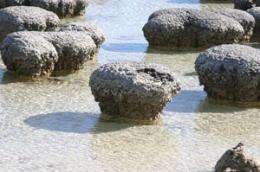Stromatolites. Credit: Macquarie University
(Phys.org)—A group of US researchers studying some of the oldest rocks in the world in the Pilbara region of Western Australia, say they have found the oldest traces of life on Earth, dated at 3.49 billion years old.
The scientists, led by Associate Professor Nora Noffke of the Old Dominion University in Norfolk, Virginia, did not strictly find fossils of that age, but actually found web-like patterns criss-crossing the surfaces of the Pilbara sandstone. Dr. Noffke calls the patterns and textures Microbially Induced Sedimentary Structures (MISS) and said the structures were created by a complete ecosystem of different types of bacteria living in the Archean eon (roughly 3.8 to 2.5 GA) almost three-and-a-half billion years ago.
The Pilbara region is a popular area for scientists searching for traces of early life on the planet because the ancient sedimentary rocks are extremely well preserved. The rocks were originally sand, and the region was originally a coastal plain. The sand was then built up into microbial mats by microbes, and over time the sand turned to rock and preserved the bacterial mats and structures such as MISS.
A separate group of scientists working in the Pilbara published a paper last year describing their find of microbial fossil traces dated at around 3.4 billion years old. Similar fossils have also been found by Noffke's group in sedimentary rocks in South Africa, but these were dated at 2.9 billion years old.
Noffke's team measured the carbon content in the rock and examined the ratio of carbon-13 to carbon-12. In non-living sources the ratio is around 1:99, while in photosynthesizing bacteria and other living organisms there is even less C13. Noffke and her group found the ratio in their samples was consistent with organic carbon. Unfortunately, there were no traces of preserved fats, proteins or fossilized microbes to definitely confirm the material is from living organisms.
Microbial mats still form today in a few places such as the Pilbara. They contain mats of photosynthesizing cyanobacteria that produce food for use by themselves and other bacteria in the mat, and they also produce oxygen through photosynthesis. Cyanobacteria are believed to have created the Earth's oxygen around 2.4 billion years ago.
Dr. Noffke said her findings could help in the search for signs of early life on other planets, by giving more information on what to look for, as explained in an earlier Phys.Org article.
Dr. Noffke presented the paper at the annual meeting of the Geological Society of America in Charlotte, North Carolina in November.
More information: A MICROBIAL ECOSYSTEM IN AN ANCIENT SABKHA OF THE 3.49 GA PILBARA, WESTERN AUSTRALIA, AND COMPARISON WITH MESOARCHEAN, NEOPROTEROZOIC AND PHANEROZOIC EXAMPLES, gsa.confex.com/gsa/2012AM/webp … ram/Paper205981.html
Abstract
Gerald Friedman's actualistic research on microbial processes in modern coastal sabkhas has opened the path of understanding of ancient microbial biota. Some of Earth's oldest sedimentary rocks exposed in the Pilbara area of Western Australia include a mixed carbonate-evaporite-siliciclastic coastal sabkha. In the present day such sabkhas are widely colonized by microbial mats. Interacting with sedimentary processes such as erosion or evaporate crystal growth the microbial mats generate biogenic structures such as stromatolites or MISS. In the Pilbara area of Western Australia stromatolites occur which belong to the oldest fossils in Earth history. However, there also exists a plethora of well preserved MISS. These structures represent an entire ecosystem of surprising diversity. Actualistic comparison of fossil and modern biogenic structures and their facies-related distribution in sabkha settings points towards the presence of microbial communities in the Paleoarchean time highly similar to those we are familiar with today.
© 2013 Phys.org























